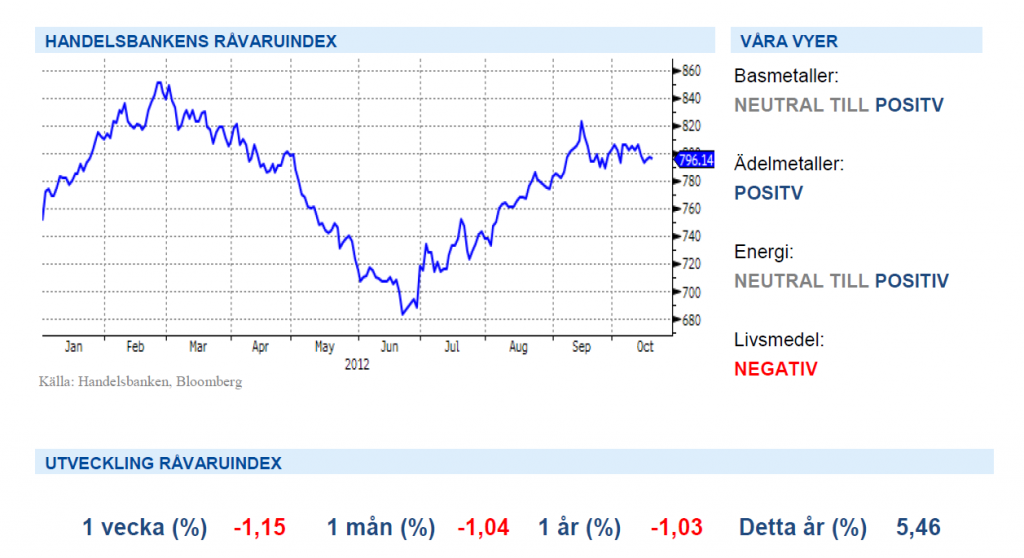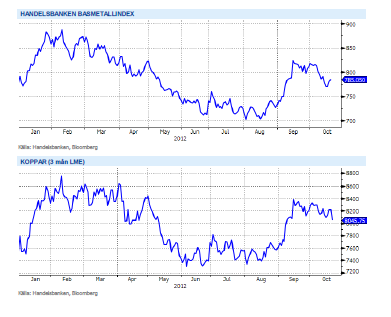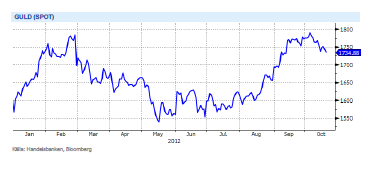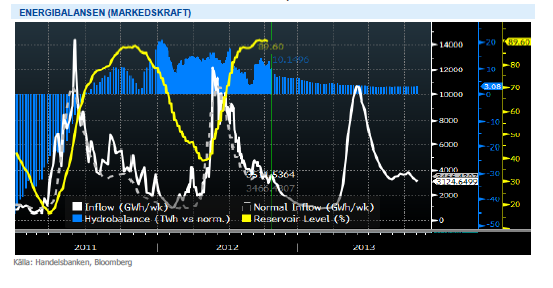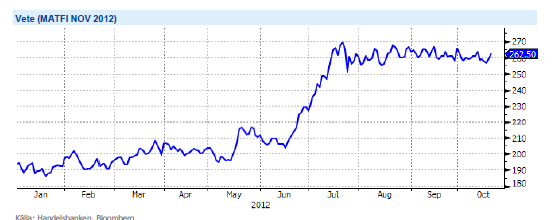Analys
SHB Råvarubrevet 19 oktober 2012
 Efter en ny vecka med blandade makrosignaler är vi någonstans mellan neutrala till positiva till risksentimentet. Riskrallyt drivet av QE3 förstärker makro, speciellt i USA men förväntningarna på den globala återhämningen har skruvats ner de senaste veckorna, kanske för mycket och det finns möjlighet till positiva överraskningar i närtid. Vi tror att valet i USA och ledarskiftet i Kina plus rapport säsongen håller uppe riskviljan de kommande veckorna. Valet i USA tar bort fiscal cliff diskussionen ur fokus vilket är positivt för riskviljan.
Efter en ny vecka med blandade makrosignaler är vi någonstans mellan neutrala till positiva till risksentimentet. Riskrallyt drivet av QE3 förstärker makro, speciellt i USA men förväntningarna på den globala återhämningen har skruvats ner de senaste veckorna, kanske för mycket och det finns möjlighet till positiva överraskningar i närtid. Vi tror att valet i USA och ledarskiftet i Kina plus rapport säsongen håller uppe riskviljan de kommande veckorna. Valet i USA tar bort fiscal cliff diskussionen ur fokus vilket är positivt för riskviljan.
Basmetallerna har åter vänt uppåt efter sitt fall på 6,5 % från toppen i september, vi byter därför fot från neutral till något positivare igen. Råoljan fortsätter handlas i sitt intervall mellan 109 och 117 och vi tycker att fundamenta är väl balanserat och motiverar att vara neutral. Även el, som vi hoppas på inför vintern med nedpressade förväntningar ligger kvar i sitt intervall och vi väntar fortfarande på rätt köpläge. Håll dock el under bevakning, vintern närmar sig och där-med riskerna. El är volatil och när det vänder upp går det snabbt.
Basmetallerna
Har vinden vänt för metallerna?
Efter två veckor med fallande priser på basmetaller har priserna vänt upp denna vecka. Vårt basmetallsindex är upp 1,95 % sedan måndag. Onsdagens besked om bättre än väntad byggaktivitet i USA fick metallerna att stiga på förväntningar om större efterfrågan. Dock vände samtliga metaller ned under fredagen och suddade ut mycket av veckans uppgångar.
Vi har även deltagit på årets LME-vecka som ägde rum under veckan. om vi sammanfattar kontentan av årets LME, så väntar alla på vad som ska hända i Kina efter ledarskapsskiftet. De presentationer som gavs var alla slående lika till innehållet; Kina, Eurokrisen och USA:s fiscal cliff dominerade utan att ge något banbrytande på endera tema. Du som prenumerant kan läsa en separat rapport från LME-veckan som bifogats i utskicket. Vi går från att vara neutrala på basmetaller till något positiv.
Efter två veckor med fallande priser på basmetaller är vi åter positiva. Vi tror på: BASMET H
Ädelmetaller
Fortsatt strejk i Sydafrikas gruvor
Vi lägger ytterligare en vecka med små rörelser bakom oss. Handelsbankens ädelmetallindex har stigit med knappa 0,6 %. Guldet handlas på 1 % lägre priser än förra veckan till följd av bättre än väntat ekonomisk data från både USA och Kina. Vi behåller fortsatt en positiv syn för denna sektor, där centralbankernas stimulanspengar är det främsta skälet.
I Sydafrika fortsätter guldgruvorna kampen att förmå sin arbetskraft att återvända i arbete. AngloGold, 3:e största producenten av guld, har sedan strejken startade den 25 september förlorat 90 000 uns i produktion. 15 000 arbetare av Gold Fields, den fjärde störs-ta producenten, strejkar fortfarande. En del arbetare är åter i arbete vid Gold Fields gruva i Beatrix , men det är för tidigt att avgöra om strejken där har kommit till sitt slut. Rapporter om våldsamheter vid flertalet gruvor verkar inte upphöra.
Vi fortsätter att se centralbankernas nytryckta pengar och framförallt Feds QE3 operation som starkt skäl att vara investerad i ädelmetallerna. Konflikterna i Sydafrika fortsätter och ger stöd åt Platina- och guldpriset. Vi tror på: ADELMET H
Energi
Oljan under press
Priset på olja har pressats under veckan och handlas nu på 112,20 USD/fat, vilket är 2,2 % lägre än samma tid förra veckan. Källor inom industrin hävdar att Saudiarabien producerade 9,77 miljoner fat/dag under september månad. Det är nära till de 10 miljoner fat/dag som pumpats upp under de senaste månaderna. Detta uppväger effekterna av EU:s hårdare sanktioner mot Iran som godkändes 15 oktober. Amerikanska oljelager visade på stigande lager, 2,9 miljoner fat mot förväntade 1,5 miljoner fat.
Elmarknaden och första kvartalet 2013 handlas upp strax under 2 procent denna vecka efter att väderprognoserna slagit om till ett kallare scenario samt stigande priser på både gas och tysk el. Ett ökat intresse för utsläppsrätter efter signaler om att EU-Kommissionen kommer att verka för att minska utbudet framöver. EU-Kommissionen släpper sin nästa rapport den 14 november och allokeringen ser att minska med antingen 400m, 900m eller 1,200m ton och man förväntas dessutom lägga fram en plan för ett globalt direktiv. Utsläppsrätterna har nu stigit med närmare 9 procent på en månad. Annars är det mest fokus på väder (senaste prognos 2-3 grader under normalt för de kommande 10-dagarna) där lägre temperaturer till viss del balanseras av en god tillgång på vatten. Energibalansen visar på ett överskott om ca 10 TWh.
Oljan har sett allt svagare ut och vi fortsätter tycka att underliggande fundamenta är väl balanserad. El börjar se intressant ut inför vintern då riskerna på elmarknaden tilltar men vi låter sektorsynen vara neutral till positiv.
Livsmedel
Torrt för höstvetet i USA
Terminspriser på vete har i veckan gått upp i Chicago men ned något i Paris. Än behövs det mer regn på det nysådda höstvetet i USA, en del småskurar då och då lindrar dock situationen något. Även i Australien är det mestadels torrt för vetet, endast små regnmängder har fallit i de västra och de syd-östra delarna av landet – merparten i marknaden börjar nu förvänta sig en australiensisk veteproduktion ner mot 20 miljoner ton, att jämföra med USDA:s senaste uppskattning om 23 miljoner ton.
I Europa råder mestadels torrt väder nu (även om det knappast känns så i vissa delar av Sverige), vilket gynnar återstående sådd. Inte mycket av den europeiska sådden kvarstår nu, generellt sett har sådden avklarats väl men det myckna regnandet i Storbritannien, som tidigare skapat stora problem med skördearbetet, orsakar nu även ganska stora problem för sådden. De ryska lantbrukarna önskar mer regn, inte minst på grund av högre temperaturer än normalt för säsongen. I Ukraina har det däremot regnat något för mycket, vilket skapar vissa problem med återstående sådd.
Väldigt mycket negativt är nu inprisat i dagens nivå och vi förväntar oss viss svårighet för priserna att nå så mycket högre. Långsiktigt är det svårt att se varför dagens nära rekordhöga priser ska hålla i sig – även om väldigt mycket kan hända till dess.
Vi ser soja, majs och vete som klara säljcase där vi väntar oss prisfall före jul men senast till påsk. Vi tror på: LIVSMEDEL S H
Handelsbankens Råvaruindex
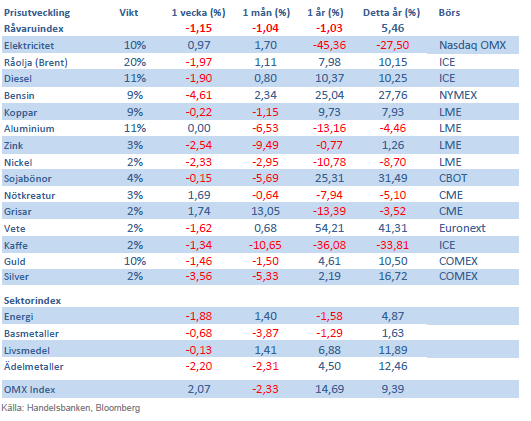
Handelsbankens råvaruindex består av de underliggande indexen för respektive råvara. Vikterna är bestämda till hälften från värdet av global produktion och till hälften från likviditeten i terminskontrakten.
[box]SHB Råvarubrevet är producerat av Handelsbanken och publiceras i samarbete och med tillstånd på Råvarumarknaden.se[/box]
Ansvarsbegränsning
Detta material är producerat av Svenska Handelsbanken AB (publ) i fortsättningen kallad Handelsbanken. De som arbetar med innehållet är inte analytiker och materialet är inte oberoende investeringsanalys. Innehållet är uteslutande avsett för kunder i Sverige. Syftet är att ge en allmän information till Handelsbankens kunder och utgör inte ett personligt investeringsråd eller en personlig rekommendation. Informationen ska inte ensamt utgöra underlag för investeringsbeslut. Kunder bör inhämta råd från sina rådgivare och basera sina investeringsbeslut utifrån egen erfarenhet.
Informationen i materialet kan ändras och också avvika från de åsikter som uttrycks i oberoende investeringsanalyser från Handelsbanken. Informationen grundar sig på allmänt tillgänglig information och är hämtad från källor som bedöms som tillförlitliga, men riktigheten kan inte garanteras och informationen kan vara ofullständig eller nedkortad. Ingen del av förslaget får reproduceras eller distribueras till någon annan person utan att Handelsbanken dessförinnan lämnat sitt skriftliga medgivande. Handelsbanken ansvarar inte för att materialet används på ett sätt som strider mot förbudet mot vidarebefordran eller offentliggörs i strid med bankens regler.
Analys
Sell the rally. Trump has become predictable in his unpredictability

Hesitant today. Brent jumped to an intraday high of $66.36/b yesterday after having touched an intraday low of $60.07/b on Monday as Indian and Chinese buyers cancelled some Russian oil purchases and instead redirected their purchases towards the Middle East due to the news US sanctions. Brent is falling back 0.4% this morning to $65.8/b.

It’s our strong view that the only sensible thing is to sell this rally. In all Trump’s unpredictability he has become increasingly predictable. Again and again he has rumbled about how he is going to be tough on Putin. Punish Putin if he won’t agree to peace in Ukraine. Recent rumbling was about the Tomahawk rockets which Trump threatened on 10 October and 12 October to sell/send to Ukraine. Then on 17 October he said that ”the U.S. didn’t want to give away weapons (Tomahawks) it needs”.
All of Trump’s threats towards Putin have been hot air. So far Trump’s threats have been all hot air and threats which later have evaporated after ”great talks with Putin”. After all these repetitions it is very hard to believe that this time will be any different. The new sanctions won’t take effect before 21. November. Trump has already said that: ”he was hoping that these new sanctions would be very short-lived in any case”. Come 21. November these new sanctions will either evaporate like all the other threats Trump has thrown at Putin before fading them. Or the sanctions will be postponed by another 4 weeks or 8 weeks with the appearance that Trump is even more angry with Putin. But so far Trump has done nothing that hurt Putin/Russia. We can’t imagine that this will be different. The only way forward in our view for a propre lasting peace in Ukraine is to turn Ukraine into defensive porcupine equipped with a stinging tail if need be.
China will likely stand up to Trump if new sanctions really materialize on 21 Nov. Just one country has really stood up to Trump in his tariff trade war this year: China. China has come of age and strength. I will no longer be bullied. Trump upped tariffs. China responded in kind. Trump cut China off from high-end computer chips. China put on the breaks on rare earth metals. China won’t be bullied any more and it has the power to stand up. Some Chinese state-owned companies like Sinopec have cancelled some of their Russian purchases. But China’s Foreign Ministry spokesperson Guo Jiakun has stated that China “oppose unilateral sanctions which lack a basis in international law and authorization of the UN Security Council”. Thus no one, not even the US shall unilaterally dictate China from whom they can buy oil or not. This is yet another opportunity for China to show its new strength and stand up to Trump in a show of force. Exactly how China choses to play this remains to be seen. But China won’t be bullied by over something as important as its oil purchases. So best guess here is that China will defy Trump on this. But probably China won’t need to make a bid deal over this. Firstly because these new sanctions will either evaporate as all the other threats or be postponed once we get to 21 November. Secondly because the sanctions are explicit towards US persons and companies but only ”may” be enforced versus non-US entities.
Sanctions is not a reduction in global supply of oil. Just some added layer of friction. Anyhow, the new sanctions won’t reduce the supply of Russian crude oil to the market. It will only increase the friction in the market with yet more need for the shadow fleet and ship to ship transfer of Russian oil to dodge the sanctions. If they materialize at all.
The jump in crude oil prices is probably due to redirections of crude purchases to the Mid-East and not because all speculators are now turned bullish. Has oil rallied because all speculators now suddenly have turned bullish? We don’t think so. Brent crude has probably jumped because some Indian and Chinese oil purchasers of have redirected their purchases from Russia towards the Mid-East just in case the sanctions really materializes on 21 November.
Analys
Brent crude set to dip its feet into the high $50ies/b this week

Parts of the Brent crude curve dipping into the high $50ies/b. Brent crude fell 2.3% over the week to Friday. It closed the week at $61.29/b, a slight gain on the day, but also traded to a low of $60.14/b that same day and just barely avoided trading into the $50ies/b. This morning it is risk-on in equities which seems to help industrial metals a little higher. But no such luck for oil. It is down 0.8% at $60.8/b. This week looks set for Brent crude to dip its feet in the $50ies/b. The Brent 3mth contract actually traded into the high $50ies/b on Friday.

The front-end backwardation has been on a weakening foot and is now about to fully disappear. The lowest point of the crude oil curve has also moved steadily lower and lower and its discount to the 5yr contract is now $6.8/b. A solid contango. The Brent 3mth contract did actually dip into the $50ies/b intraday on Friday when it traded to a low point of $59.93/b.
More weakness to come as lots of oil at sea comes to ports. Mid-East OPEC countries have boosted exports along with lower post summer consumption and higher production. The result is highly visibly in oil at sea which increased by 17 mb to 1,311 mb over the week to Sunday. Up 185 mb since mid-August. On its way to discharge at a port somewhere over the coming month or two.
Don’t forget that the oil market path ahead is all down to OPEC+. Remember that what is playing out in the oil market now is all by design by OPEC+. The group has decided that the unwind of the voluntary cuts is what it wants to do. In a combination of meeting demand from consumers as well as taking back market share. But we need to remember that how this plays out going forward is all at the mercy of what OPEC+ decides to do. It will halt the unwinding at some point. It will revert to cuts instead of unwind at some point.
A few months with Brent at $55/b and 40-50 US shale oil rigs kicked out may be what is needed. We think OPEC+ needs to see the exit of another 40-50 drilling rigs in the US shale oil patches to set US shale oil production on a path to of a 1 mb/d year on year decline Dec-25 to Dec-26. We are not there yet. But a 2-3 months period with Brent crude averaging $55/b would probably do it.
Oil on water increased 17 mb over the week to Sunday while oil in transit increased by 23 mb. So less oil was standing still. More was moving.

Crude oil floating storage (stationary more than 7 days). Down 11 mb over week to Sunday

The lowest point of the Brent crude oil curve versus the 5yr contract. Weakest so far this year.

Crude oil 1mth to 3mth time-spreads. Dubai held out strongly through summer, but then that center of strength fell apart in late September and has been leading weakness in crude curves lower since then.

Analys
Crude oil soon coming to a port near you

Rebounding along with most markets. But concerns over solidity of Gaza peace may also contribute. Brent crude fell 0.8% yesterday to $61.91/b and its lowest close since May this year. This morning it is bouncing up 0.9% to $62.5/b along with a softer USD amid positive sentiment with both equities and industrial metals moving higher. Concerns that the peace in Gaza may be less solid than what one might hope for also yields some support to Brent. Bets on tech stocks are rebounding, defying fears of trade war. Money moving back into markets. Gold continues upwards its strong trend and a softer dollar helps it higher today as well.

US crude & products probably rose 5.6 mb last week (API) versus a normal seasonal decline of 2.4 mb. The US API last night partial and thus indicative data for US oil inventories. Their data indicates that US crude stocks rose 7.4 mb last week, gasoline stocks rose 3.0 mb while Distillate stocks fell 4.8 mb. Altogether an increase in commercial crude and product stocks of 5.6 mb. Commercial US crude and product stocks normally decline by 2.4 mb this time of year. So seasonally adjusted the US inventories rose 8 mb last week according to the indicative numbers by the API. That is a lot. Also, the counter seasonal trend of rising stocks versus normally declining stocks this time of year looks on a solid pace of continuation. If the API is correct then total US crude and product stocks would stand 41 mb higher than one year ago and 6 mb higher than the 2015-19 average. And if we combine this with our knowledge of a sharp increase in production and exports by OPEC(+) and a large increase in oil at sea, then the current trend in US oil inventories looks set to continue. So higher stocks and lower crude oil prices until OPEC(+) switch to cuts. Actual US oil inventory data today at 18:00 CET.
US commercial crude and product stocks rising to 1293 mb in week 41 if last nights indicative numbers from API are correct.

Crude oil soon coming to a port near you. OPEC has lifted production sharply higher this autumn. At the same time demand for oil in the Middle-East has fallen as we have moved out of summer heat and crude oil burn for power for air-conditioning. The Middle-East oil producers have thus been able to lift exports higher on both accounts. Crude oil and condensates on water has shot up by 177 mb since mid-August. This oil is now on its way to ports around the world. And when they arrive, it will likely help to lift stocks onshore higher. That is probably when we will lose the last bit of front-end backwardation the the crude oil curves. That will help to drive the front-month Brent crude oil price down to the $60/b line and revisit the high $50ies/b. Then the eyes will be all back on OPEC+ when they meet in early November and then again in early December.
Crude oil and condensates at sea have moved straight up by 177 mb since mid-August as OPEC(+) has produced more, consumed less and exported more.

-

 Nyheter3 veckor sedan
Nyheter3 veckor sedanGoldman Sachs höjer prognosen för guld, tror priset når 4900 USD
-

 Nyheter4 veckor sedan
Nyheter4 veckor sedanBlykalla och amerikanska Oklo inleder ett samarbete
-

 Nyheter3 veckor sedan
Nyheter3 veckor sedanGuld nära 4000 USD och silver 50 USD, därför kan de fortsätta stiga
-

 Nyheter2 veckor sedan
Nyheter2 veckor sedanLeading Edge Materials är på rätt plats i rätt tid
-

 Nyheter3 veckor sedan
Nyheter3 veckor sedanNytt prisrekord, guld stiger över 4000 USD
-

 Nyheter4 veckor sedan
Nyheter4 veckor sedanEtt samtal om guld, olja, koppar och stål
-

 Analys4 veckor sedan
Analys4 veckor sedanOPEC+ will likely unwind 500 kb/d of voluntary quotas in October. But a full unwind of 1.5 mb/d in one go could be in the cards
-

 Nyheter4 veckor sedan
Nyheter4 veckor sedanNeptune Energy bekräftar enorma litiumfyndigheter i Tyskland


